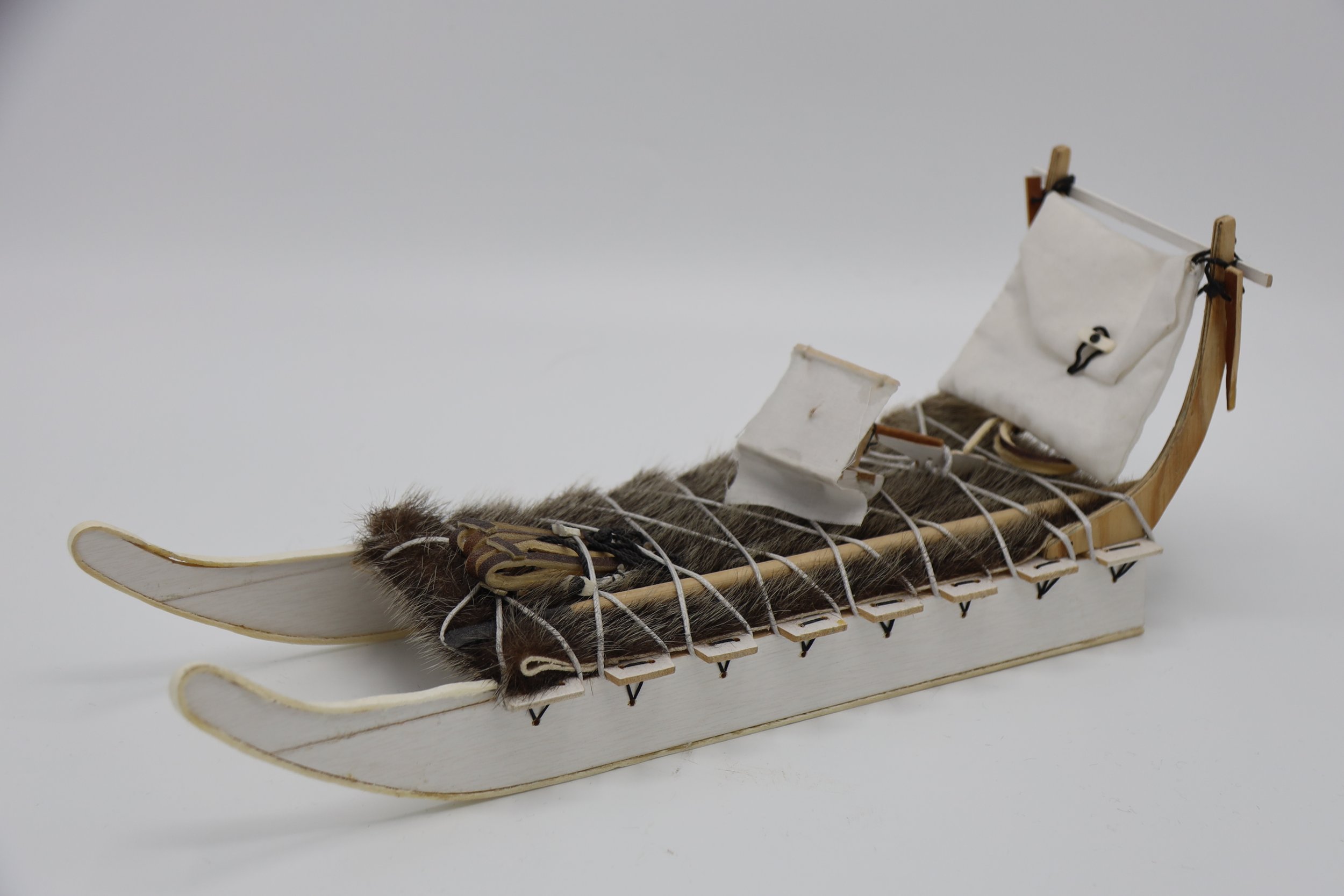
Adventure Travel Dog Sledding
“I suspect that you, like I once did, are picturing the Arctic as one endless Pingu landscape of flat ice, broken only by the occasional Berghaus-clad James Cracknell type striding manfully out of the spindrift.”
Quote Source – Alexander Armstrong
Dog Sledding
Can be in many forms, Greenlandic, Lapland Style or Carts, (complete with seats, lights and hydraulic brakes!) but whatever you choose one thing is for sure that the dogs will be loud, excited and getting louder! They love to run! These video clips were filmed in Svalbard in -20c, so trying not to get frostbite, crash the cart (I had dad and son to look after) and of course not run over the dogs! (rule No 1), my pack was faster than the others and although I couldn’t get them to run straight they certainly had the pulling power. There is water and a large ditch to the right so I am trying to keep them out of it. We had flare gun and Mauser (bolt action - reliable) 30-06 in case of Polar Bears. The bottom left hand dog is what they call a “Polar Bear” dog which is basically a dog that will take on a Polar Bear, we had a few in the crew. The whole pack will, but these are the bravest of the brave. Hopefully never needed, but Polar Bears are seriously dangerous Marine Mammals. In Svalbard if you shoot one - it is treated as almost as murder scene, and you have to explain to the Governor / Police why? They even take blood samples of the bear to check for adrenaline levels to see if you are telling the truth or not? No one wants a dead bear right?
(These clips best watched full size, please bear in mind I am trying to (and failing)to be multi tasking. There is a black out part way through as I mess about with head touch - (Lupine) the best. Lead dog is the small bitch right hand side front, although the male left hand side tries to dominate her - she’s in charge).
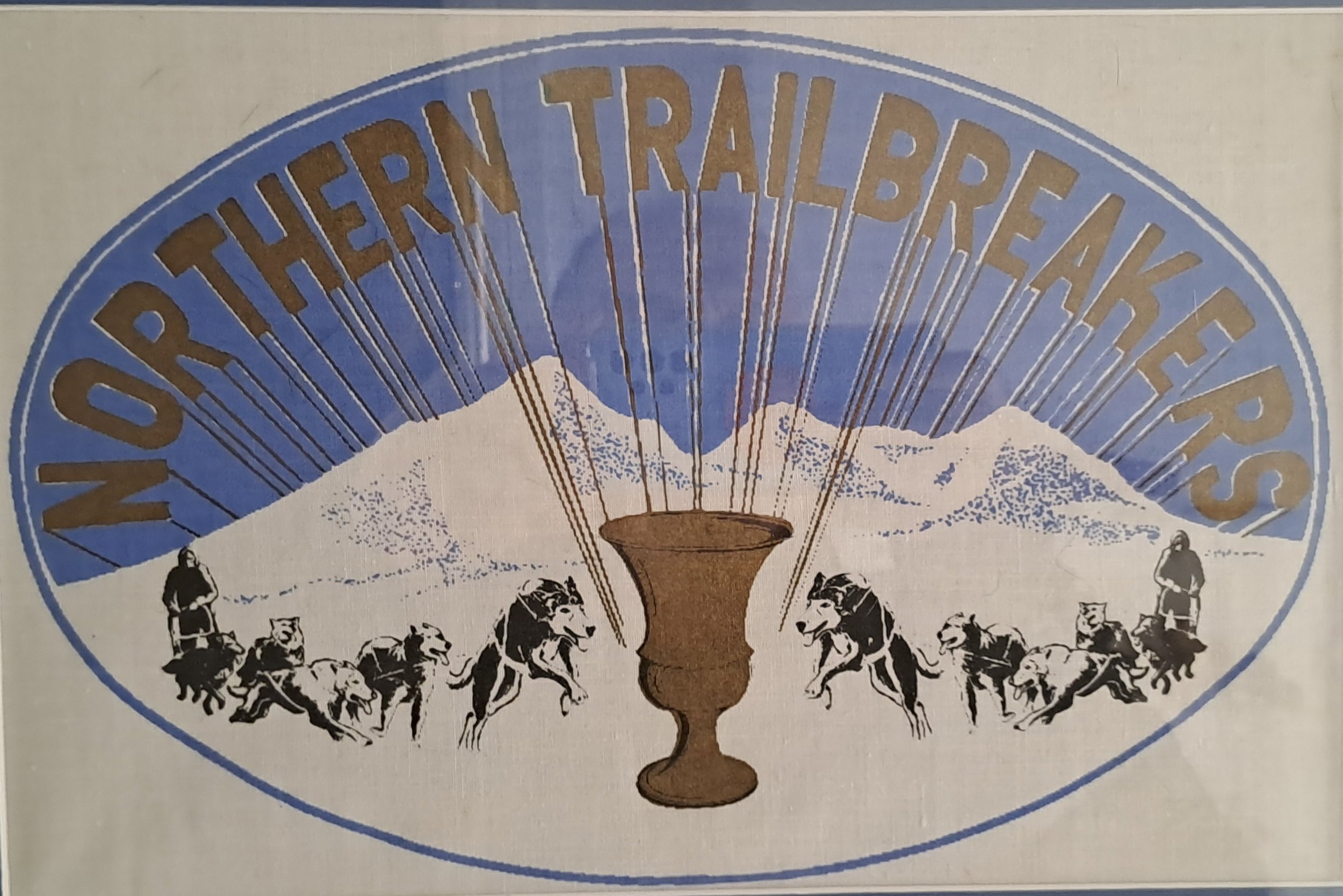
In 1984 we were made "honorary " members of the Northern Trail Breakers by Henrik Taube - Champion dog sledder of Sweden. We spent an amazing two weeks dog sledding across Lapland sleeping outside and in huts in winter.

Section of Sami items in the Travel Museum collection including Shaman drum (Finland) Traditional lapland knife 1984 (Sweden) leather pouches, birch bark box and traditional Artic Fox and stone dolls. Dog booties, mini replica Sami boots and silver / reindeer bracelets (Russian Evens peoples)
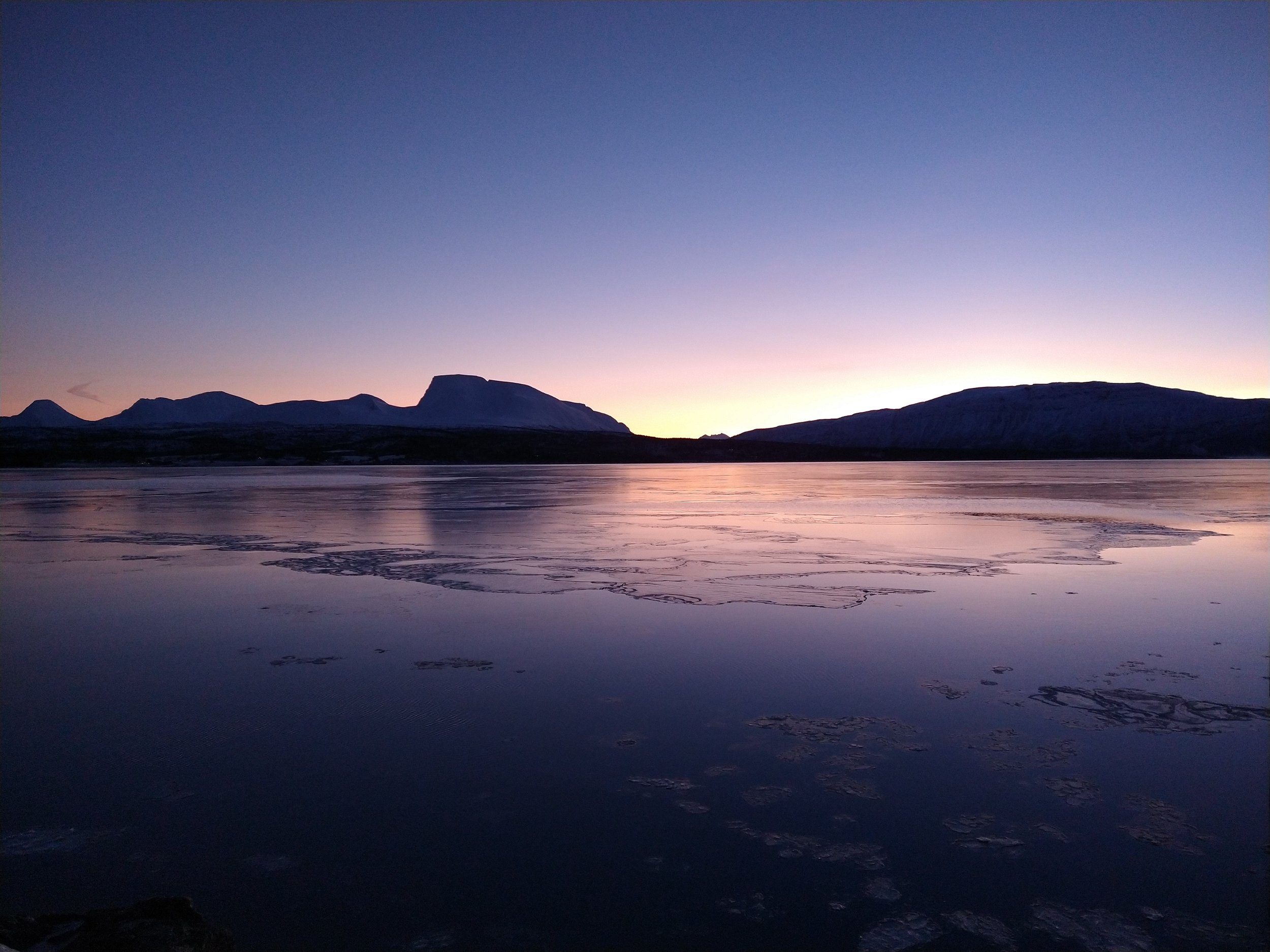
Sun setting in mid-winter over Finmark Norway
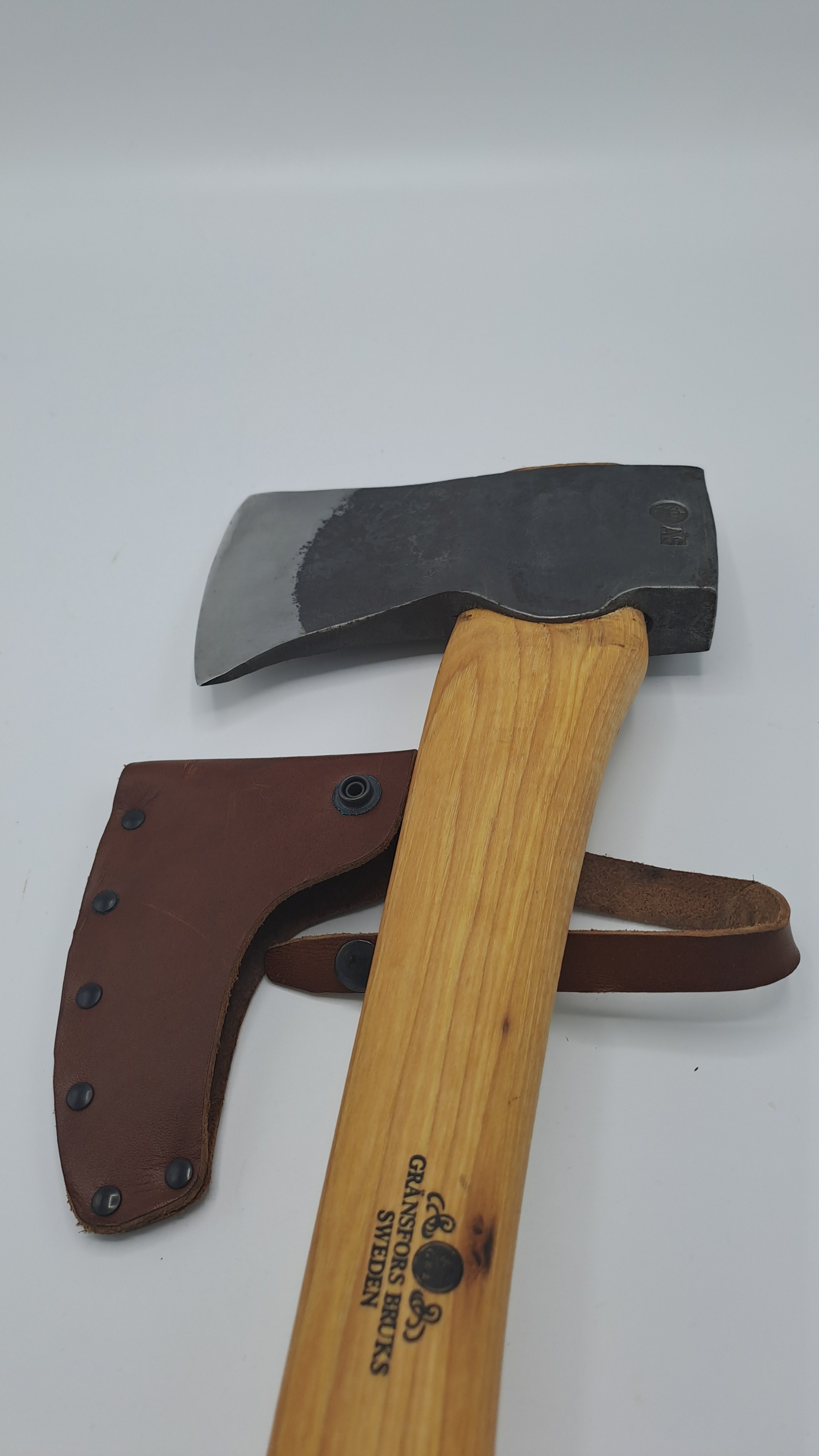
Felling Axe - Granfors This particular one was hand forged by AS - Strömstedt Anders
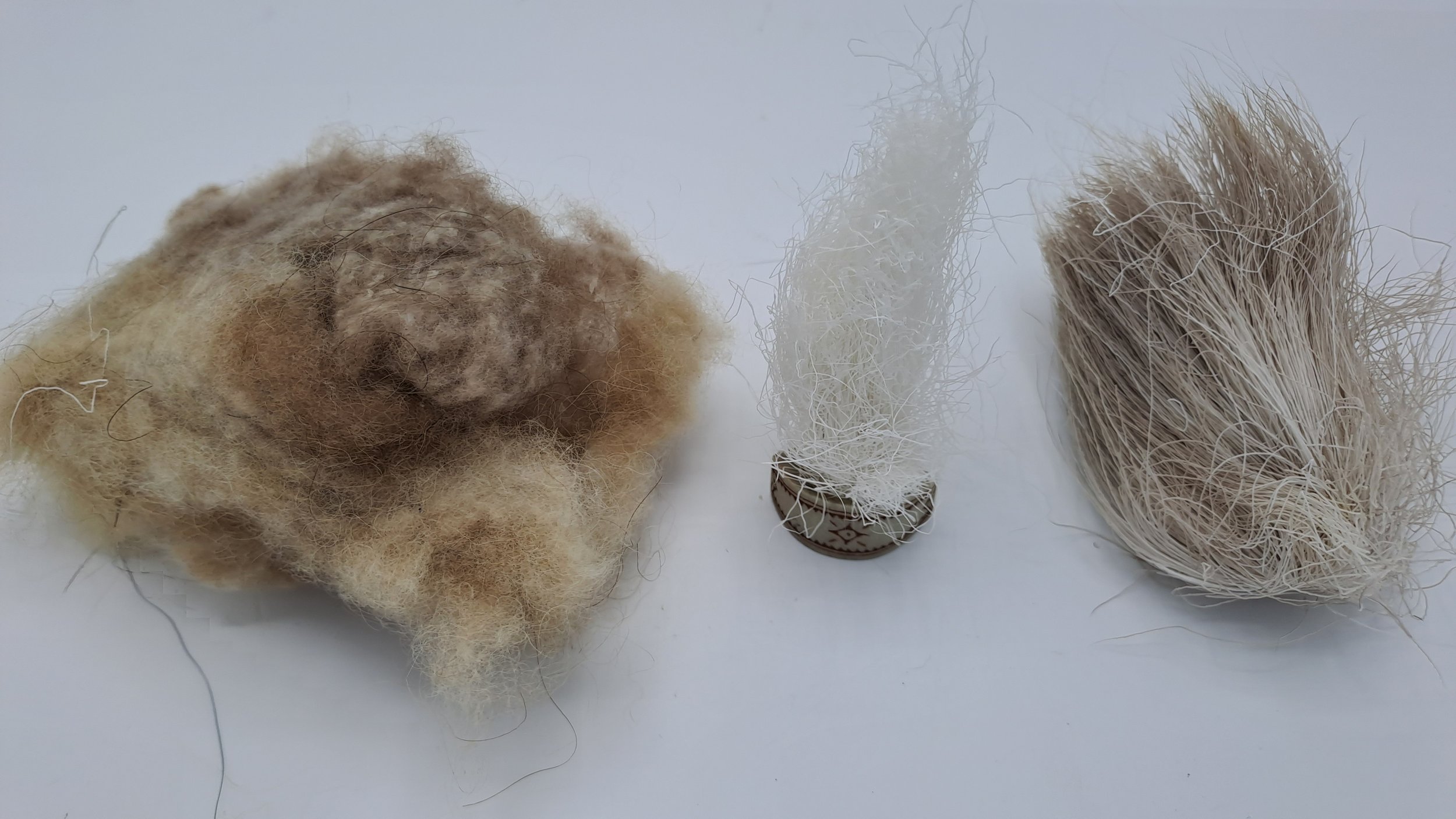
Middle fur is possibly Polar Bear (It came from Svalbard), in a reindeer antler ring with scrimshaw. The scarf ring was made locally in Jukkasjärvi c 1983 (Sweden). The other furs are left Musk Oxen and Right Svalbard Reindeer (a local subspecies with short legs). The reindeer fur was left after the deer froze to the ice and then walked off. Longyearbyen (Svalbard)

Beautiful silver wire and leather bracelets - hand crafted by an inuit from the "Evans" tribe, who mainly live in what is now Russia. It has horn button. The back one is red with silver wire and a horn button. Typical design.
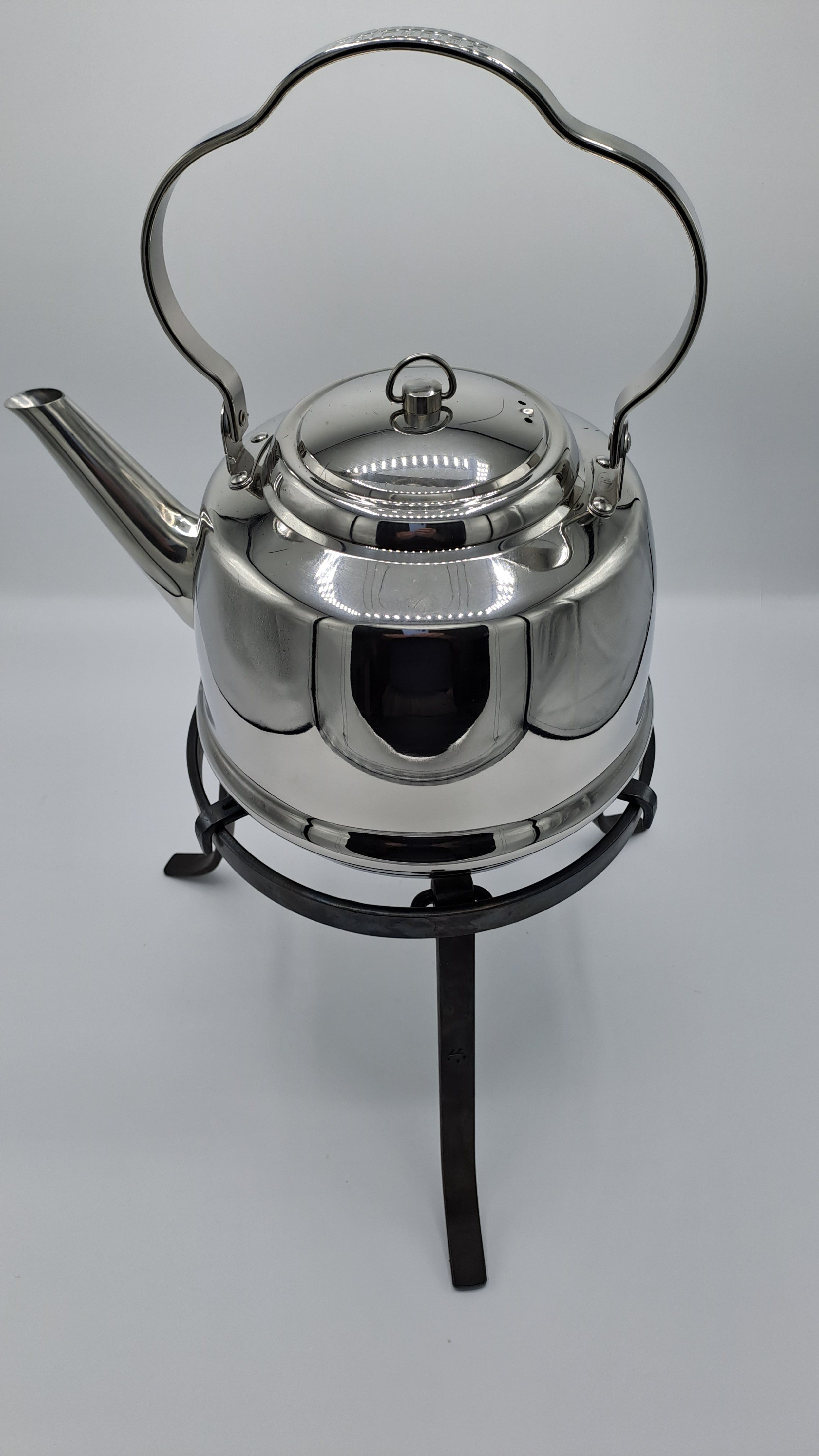
Cast Iron pot stand and kettle, which can also be hung by a chain on tall tripods.
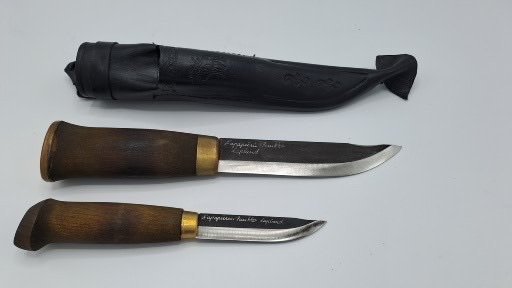
Piggy backed double knife with full size and smaller working knife. Knifes are an essential bit of kit. These were made for the "tourist" market, but are non the less a nice pair of useful knifes. Most of this type of working knife have short stocky blades of high carbon steel.
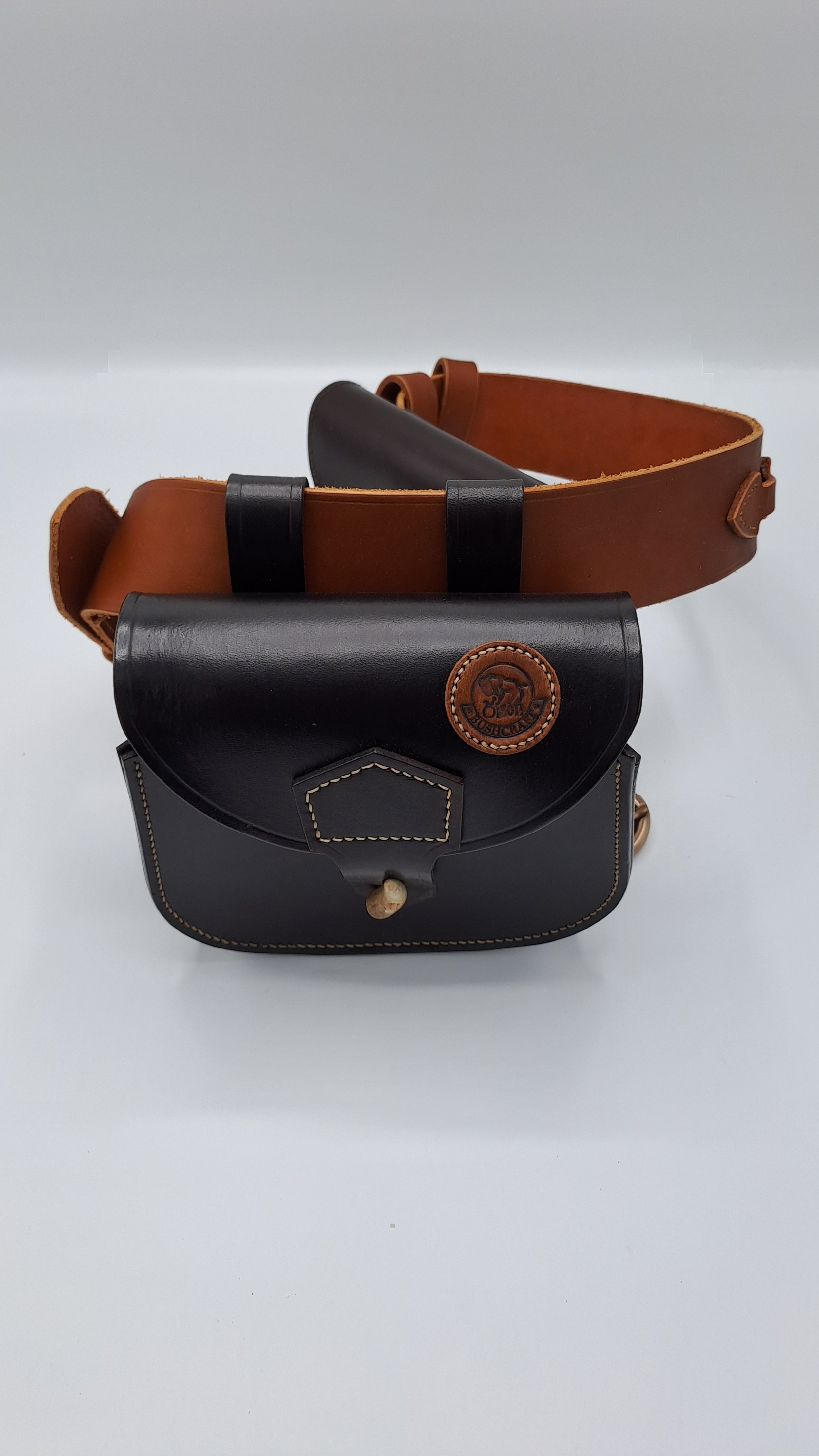
Possibles Pouch and belt - contains everything you can possibly need!
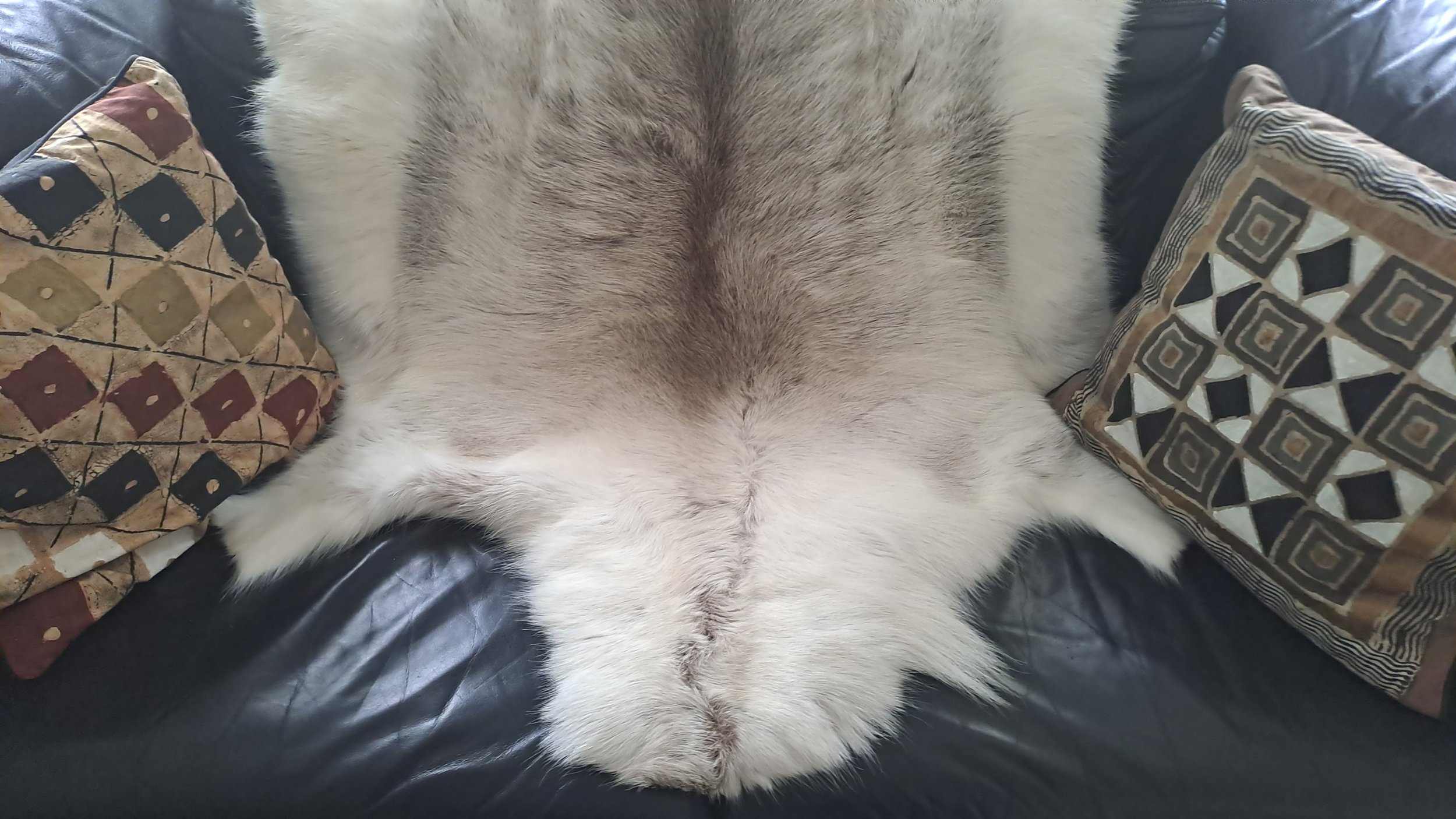
The ubiquitous reindeer skin. These are by products of using reindeer meat which is very high in protein and low in fat. The skins are essential insulation from the cold - camping, fishing, and dog sledding. This one is probably from Denmark, although it was bought in Iceland.

Canvas & leather axe and hand saw case with useful Gränsfors Bruk forest axe.
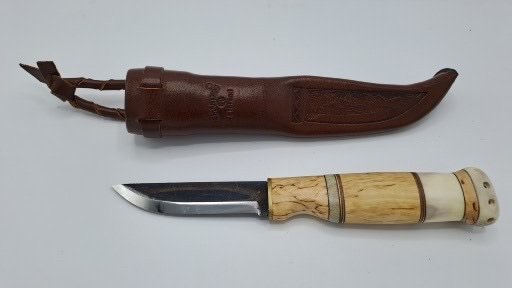
Commercially made birch and bone knife - Finland, but typical lapland style.

Snow Storm
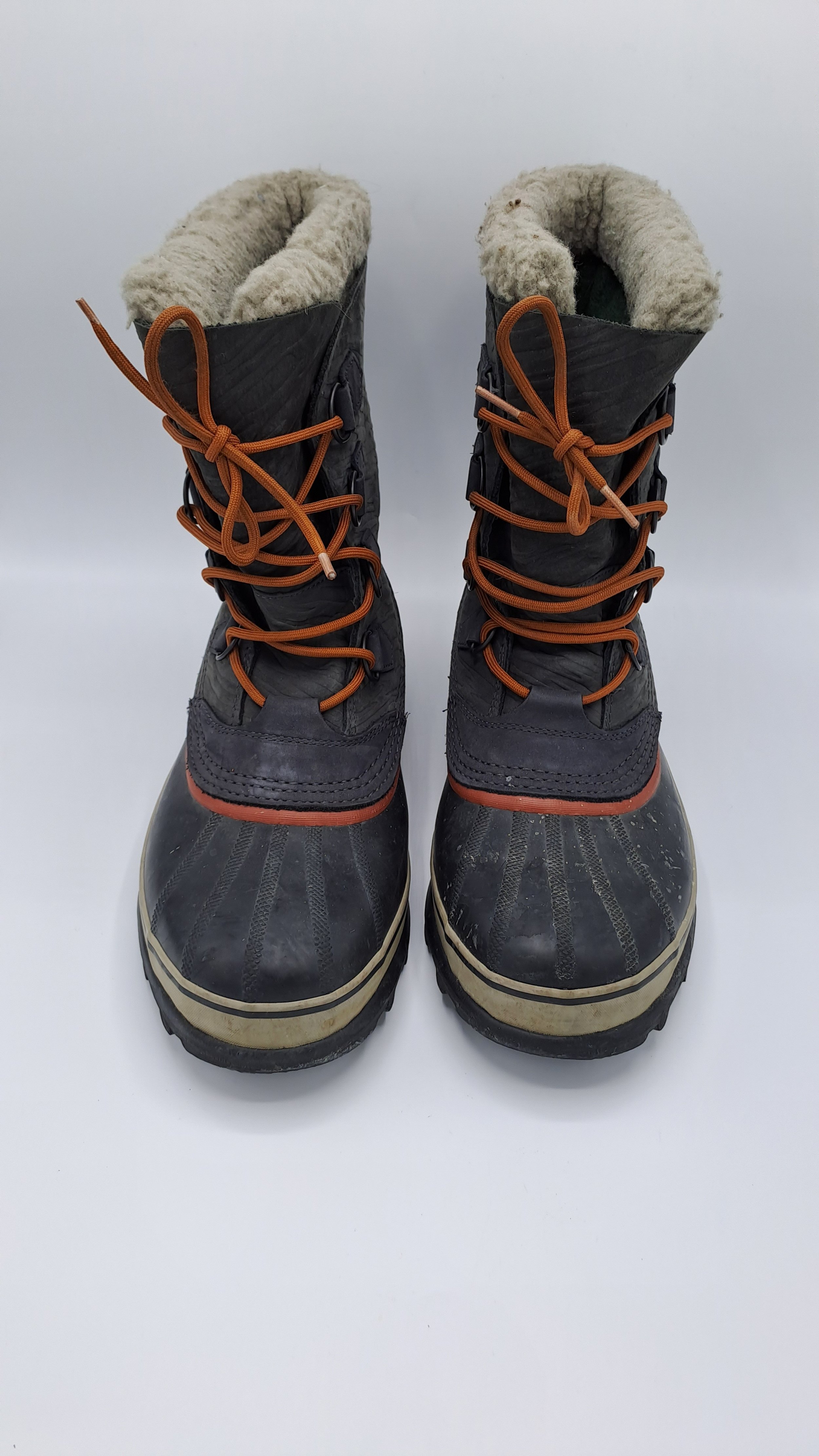
You need good boots - good as they are these are a little light for some conditions, but great down to -22c.
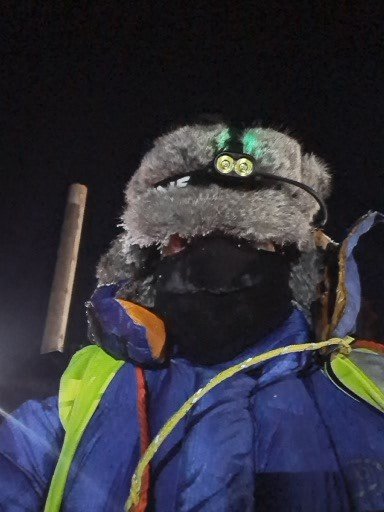
-20c Svalbard - high vis to stop being run over by trucks, cords are for gloves - not much changed from 2012 - see Scott Photos. Lupine head torch - one of the best.
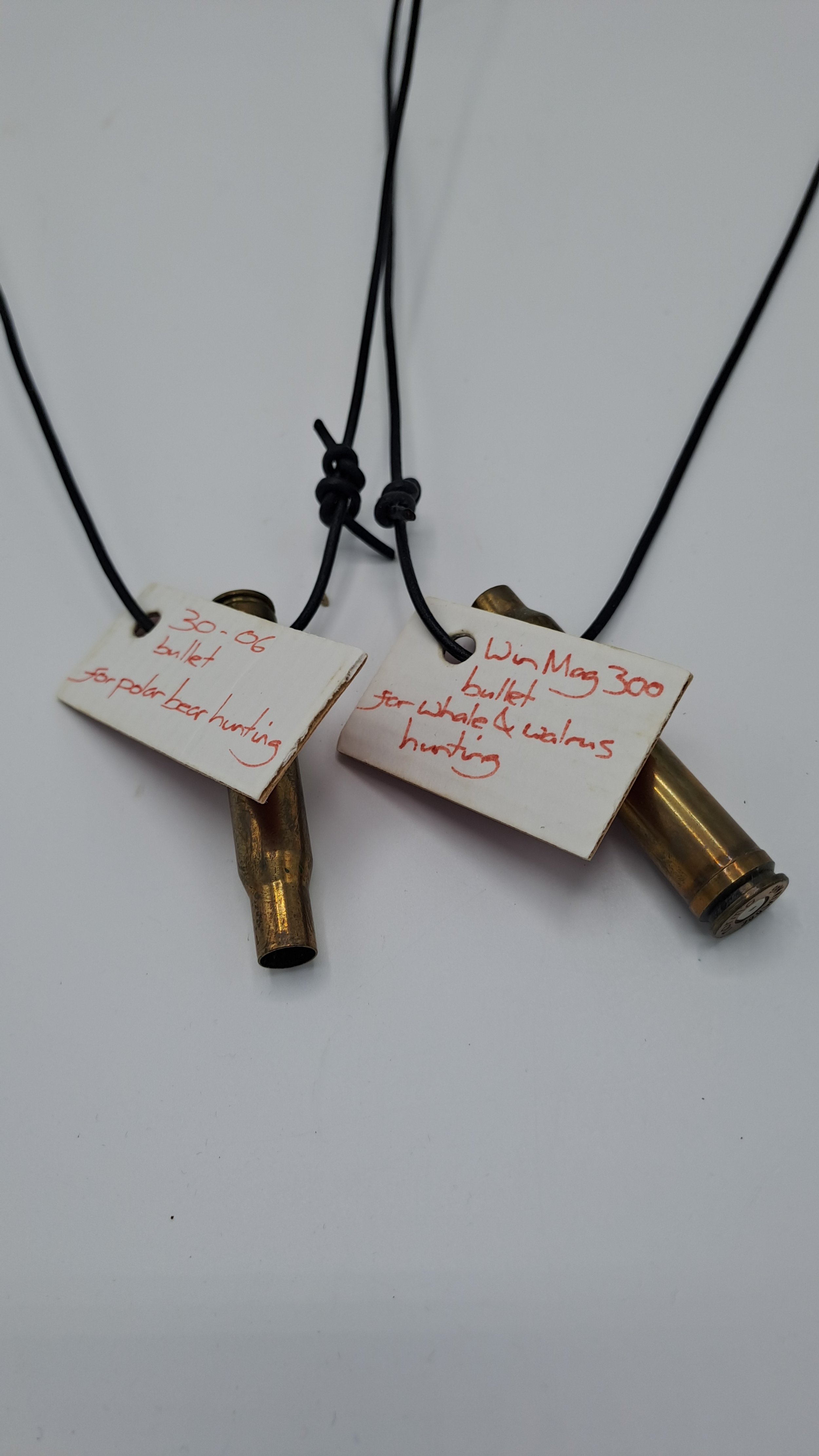
Win Mag 300 or 30-06 Polar Bear Stoppers of choice - we've never met anyone who has had to shoot one.
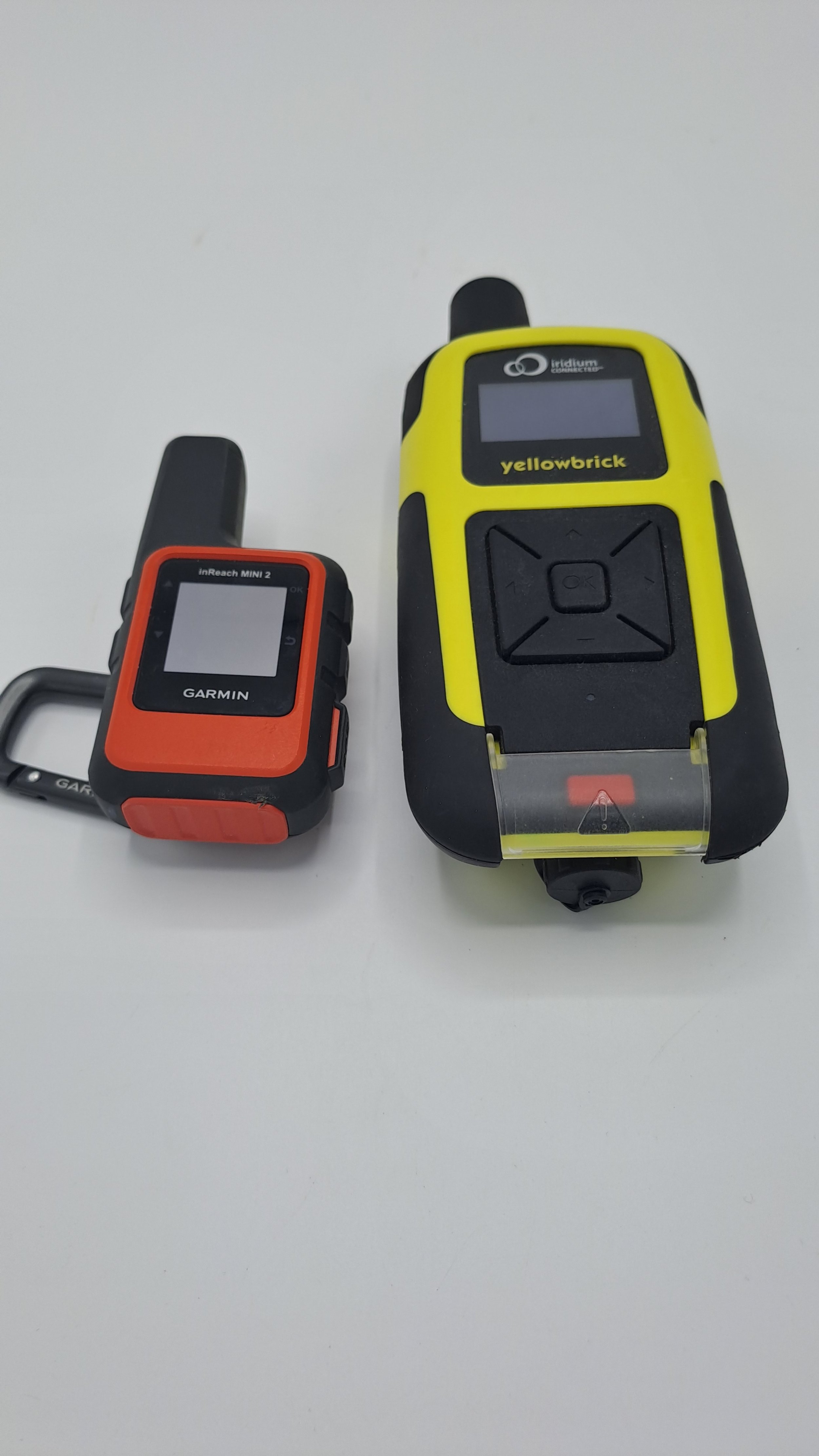
Satellite communication needed for remote locations - with SOS button - helicopter anyone , just make sure you have $20k!
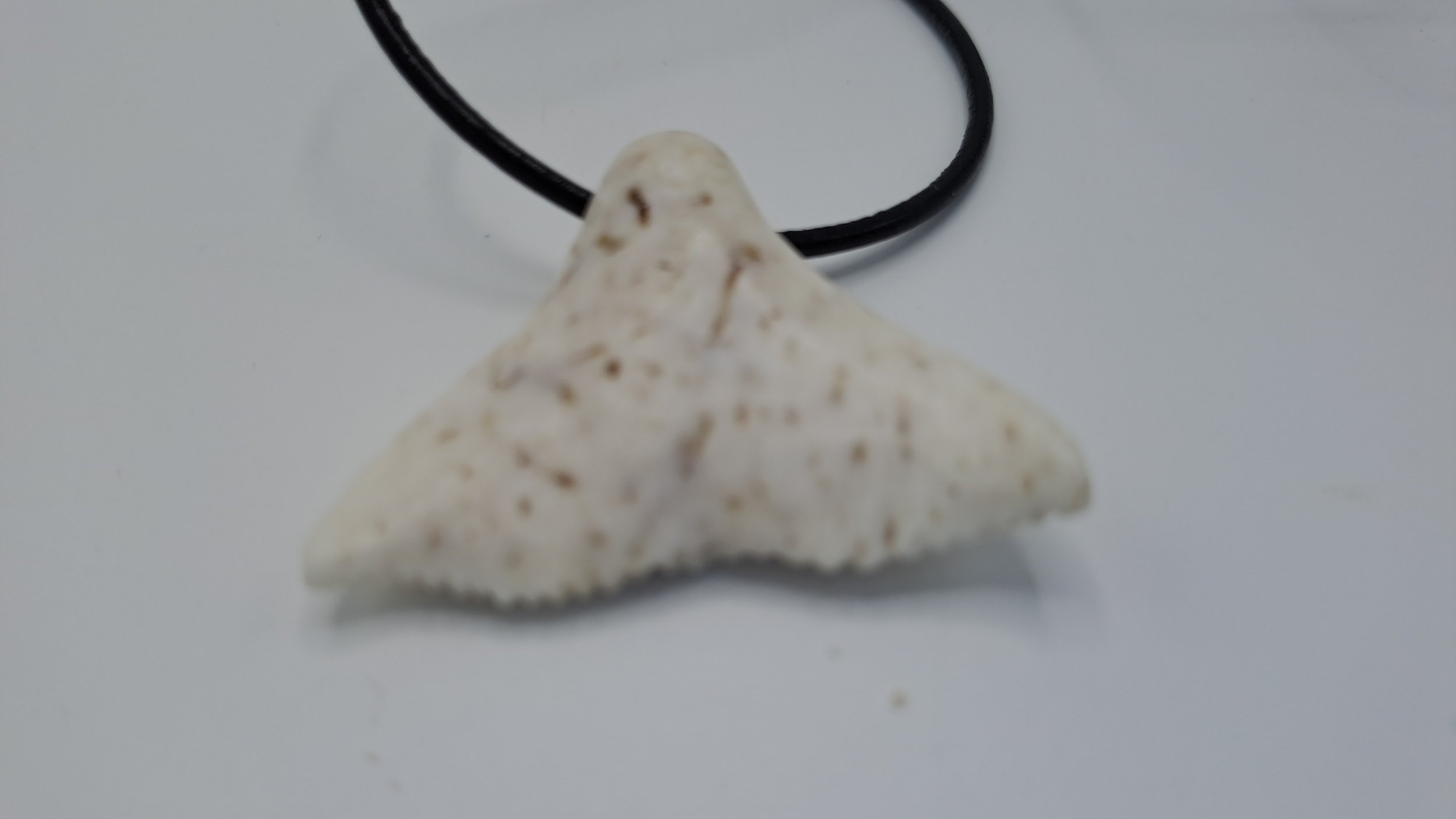
North West Greenland - Whale Fluke pendant - local materials.
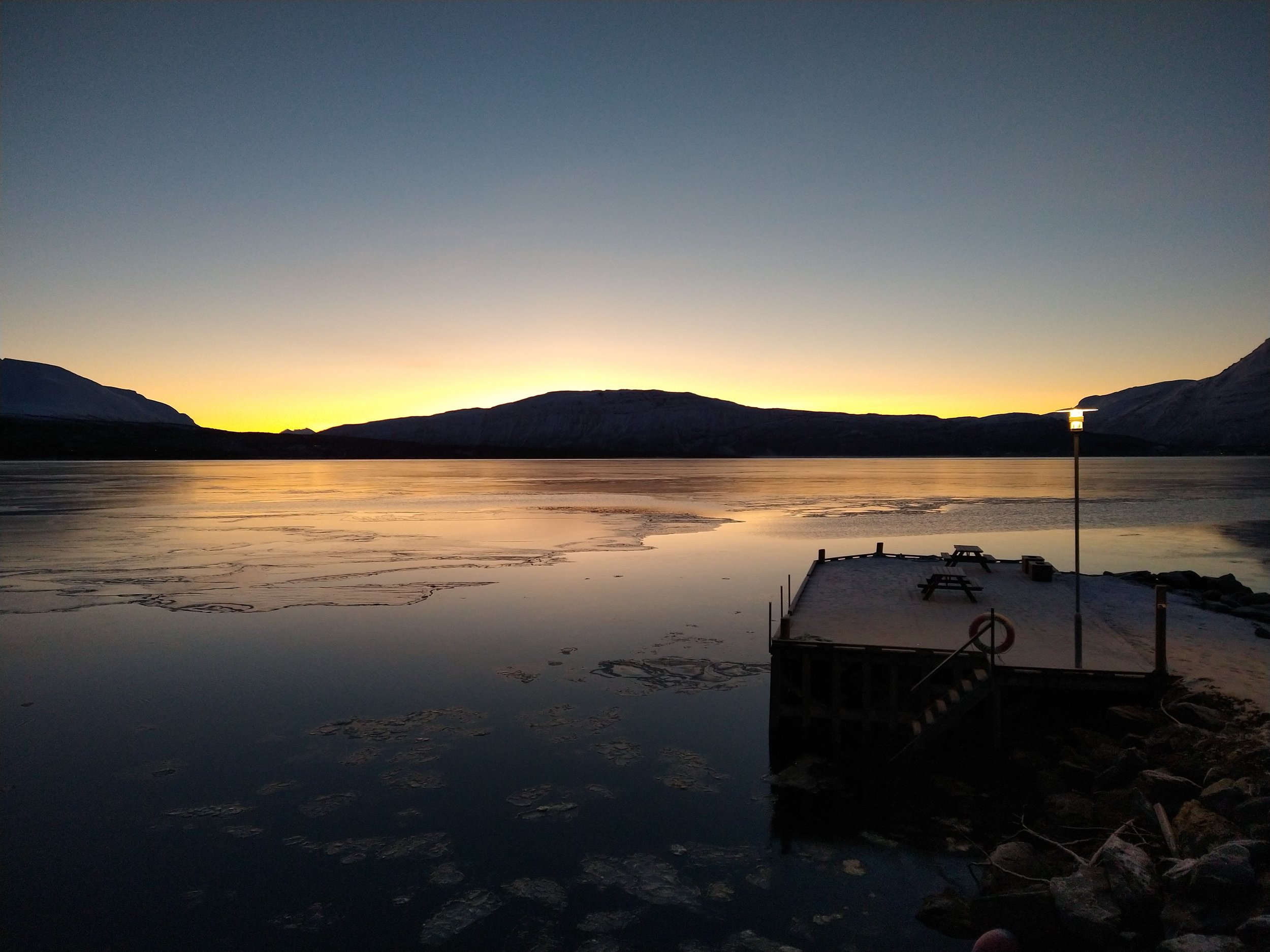
The Arctic can be stunningly beautiful - Midday sun in winter - Finmark Norway

Seal skin gloves (Ringseal - favourite food of the Polar Bear), Fin-Racoon Hat - these animals were bought in by Russian fur traders and now are a serious pest. The reality is that many sled dogs mainly eat seal and occasionally whale meat, they eat everything skin, bones and all.
Dog Sledding
We love dog sledding, even if we are not a big fans of dogs, having had a lot of run ins with farm and village dogs over the years, they just love a cyclist or hiker. There is something primal about the relationship of mans tamed wolves, and the ancient art of skidding across the snow and ice. Dogs have incredible endurance compared to us, and super senses of smell, and hearing, very useful for avoiding predators, and trouble. Packs of dogs / wolves are an efficient if somewhat gruesome hunting machine, and it is their endurance and team work which is key, and mankind relationship with dogs was based on their hunting and protective instincts, as well as their “pack” and teamwork ability.
They can run for hours on end, and still have energy left. They poo and wee on the run on a sled (they have no choice), and they tend to flick it up with their hind legs, so remember to duck, or wear sunglasses / ski goggles. If you are a good driver you will slow to allow the dog to do it s business. They also lick the snow as they go, but this is bad for their kidneys, and worse still is biting the ice, and they can get a bloody mouth, so best to get them water. They squabble and bite each other as they go, and get the occasion cut paw. Dog management is as important as human endurance management, and knowing when to stop to give your dogs a breather, or helping them out on the steeper stuff, scooting with one leg, or getting off and running or pushing, goes along way to building a relationship with the dogs, as does braking and not running them over! They always seem to look back when you brake as if to say “what the….. why are we slowing down!”
They are incredibly competitive and they will always try to overtake a slower sled, even when it is not safe to do so, you have to manage and control them, and we just tend to think of them as an engine on full throttle - they don’t stop, unless you stop them, even if you fall off! They also tend to want to cut the corner so you have to take a wide berth if you don’t want to end up in the ditch.
When it time for the off, they get incredibly excited, and the pack starts to howl and bay, they then start to pull in unison, in rhythmic, coordinated jerks, like a rugby team scrumming down, and if you are not ready for this they will go one way and you the other, flat on your backside! They accelerate to top speed like a formula one car, and then settle into cruising speed, which they can maintain for mile after mile, and just like us they go through highs and lows, getting second wind, and blowing out. They take commands and you can get them to turn left and right, or to suddenly accelerate for example when crossing a snow bridge or if you are sinking on the ice over a lake. They don’t however seem (or at least I’ve never been able to find it) to have an easy / slow / stop gear, just fast, cruise and faster! My team responded to the word “‘Moose Tracks,” which apparently sound like a Swedish word for go faster - at least for the dogs! Whatever - it worked. Some train on whistles - I work on minimum input - so as not to confuse them.
At the end of the run, it is always dogs first, machine second, and man third, however tired you are. Putting out lines to tie the dogs to, digging shallow holes and wind breaks to protect them from the wind and snow, checking paws, and making up the mush that is dinner with dog biscuits, occasional reindeer meat and water, remembering to feed them in pack order, unless you want a fight. The dogs soon curl into a ball and settle down for night, often just domes of snow come the morning. Then it’s saying hello, reaffirming pack ties, and some play fighting, breakfast and doggy ablutions, before getting them into the rigs for the next leg. I always thank the dogs with a well done, and scratch starting with the pack leader and dominate animals first to avoid fights and keep pack order.
Protectors
Old breeds like the Norwegian Elk Hound, were bred to corner Elk (Moose), and if you have ever seen an Elk they are huge animals with a pretty fearsome set of antlers to defend themselves. Elk hounds (not sled dogs) are fearsome predators, with a high prey drive, (one of the oldest breeds favoured by the Norse / Vikings) and let’s face you would have to pretty crazy to take on an elk with a pair of teeth and a few claws, and huskies also perform a similar function, as pack protectors.
We’ve seen a small ‘pack” of 3 assorted motley village dogs take on and beat a Spotted Hyena, in Ethiopia, sending it scuttling off into the bush with that peculiar gait they have, whilst the local dogs celebrated their victory, howling and barking and reaffirming their pack with sniffing and rubbing.
And we’ve been protected by a fearsome and probably one of the most “battle scared” animals we have ever seen in the form of a Rhodesian Ridgeback dog in Africa which decided to take guard outside our tent. I was not sure whom I was more scared of the Lions, Buffalo, or the Dog. Apparently it would and did take on anything on its patch - even Hippo. We were glad it was there though, although I was busting for a pee in the middle of the night.
The point is that the dogs are not just there to haul the sled but also as guards and protection, both for the “pack” and the human driver, the “pack leader,” from wolves, bears and other predators.
Pack Leader
The pulling pack also has a “pack leader”, in the form of the lead dog, usually a bitch, and they are often expert navigators, able to navigate across endless territory in all weathers. A mix of dogs is good, with the females (smaller) providing the endurance and the males (bigger) the pulling power, for up hill and deep snow, although I’ve lost count of the number of times in waste deep snow, I’ve had to struggle round to lift the dogs, one by one out of the snow and onto more compact ground, only to have them start to run, as soon as you have the let the last one up, leaving me dragging behind, until I could get back on. Those dogs sure love to run!
Occasionally you have to stop to untangle the dogs when they caught up the lines, and they are running three legged, sometimes they sort themselves out, and other times you have to step in to help and stop them getting hurt. They are your lifeline.
We’ve tried lots of types of dog sledding, in Finland, Svalbard, Sweden, Norway, Italy and Austria, 3 dog cross country, 5-6 dogs single sled, and a full 7-9 dog team for the bigger covered equipment and people sleds. We’ve dog sled through forests, aways exciting and lots of work balancing the twists and turns, (also on one occasion one of our party lost control and hit a tree and ended up with a bloody head injury and concussion), across frozen lakes and fiords, deep snow and snow bridges (don’t be the last sled as it tends to collapsing by then!), and up and down mountains, including Mount Kebnekaise (2097m) in Northern Sweden (Lapland / Sámi Land).
After a couple of weeks with the dogs, dog sledding across Sweden, we really got to start to know their characters, and when something is wrong, or they are just trying it on! You bond, but they are not pets, they are working dogs, and there are professional boundaries from both sides. They do like a bit of fuss and attention and a good belly rub!
Lapland dog sledding is very different to Greenland dog sledding - different dogs, different sleds, different terrain and different predators to deal with. In lapland you stand on the sled at the back on the extended runners, with the snow brake in-between your legs and your hands griping the wood hoop on the frame (as driver) and if you have a passenger they sit in the basket, along with the kit, rifles, cooking stuff and food (human and dog), and the sleds are narrow so you fit between trees in pine and birch woods. You use your body weight to balance the sled and corner same as a motorbike, they can and do overturn if you don’t. The dogs are like reverse speedway bike, there is a brake, but no throttle, it is just on full - all the time.
It can be tiring for the human as well, standing on the back for hours on end, shifting your weight as you twist and turn from tracks and forests, scooting with one leg, and running (or even pushing) to support the team - it is not a passive event. The basket can be uncomfortable too, no suspension, as you slam over the bumps and humps, at least your knees absorb a bit on the back. Inactive in the basket you need reindeer skins and blankets to keep warm, but tend to slide down at the front, so you constantly have to haul yourself upright. The sleds need a foot bar to stop you sliding forward, one day we will design an adjustable one, and a sprung seat!
Even as puppies huskies are heavy set dogs, powerful and strong, my boots, hands and face, have been chewed quite a lot from razor sharp little teeth. The puppies do make good hot water bottles though. As tiny puppies eyes just open (you shouldn’t handle them before this) they are little balls of fluff, with beautiful blue eyes (sometimes brown or one brown and blue!) and super cute. Mum is always pleased to see them back.
-
The dogs run in pairs, in a body harness, attached either side to a line and sometimes a single lead dog up front so the whole rig is narrow. “Trainees” may “run with the pack” unharnessed, getting a nip if they stray too close to the working dogs, or try to play. You have a snow brake, a foot operated brake, on an elasticated strap, which is basically a flat bit on timber with a metal blade that you can move up and down to progressively brake, and an ice brake,(like a handbrake on a car) which is a large, heavy, metal 2 pronged spike, you can kick into the ice or compacted snow to hold the sled and stop the dogs running off during stops and breaks. You can also tie it to a tree if there is one.
-
In Greenland you ride and drive on the sled, there are no trees, so sleds are wider to spread the load; dogs run in fan pattern to also spread the load, as often you are on sea ice. There is also a quick release knot for the dogs so that they can defend themselves and you in the event of an encounter with a polar bear. The sleds also have to be robust enough to haul back food such as musk ox / seal / fish etc, when they are used for hunting. They tend not to have any side screens like Sami sleds, I guess not practical with meat etc. Rifles may also have a small sled screen in white which you can push along the ice and hide behind at the same to get closer to prey.
-
In Lapland they tend to use a mix of Siberian and Alaskan Huskies, and well as Greenland Dogs, and often Greenland / Alaskan / Siberian crosses. I’ve also seen Red Setters, and other breeds used, but they often have insulated coats and booties, as they are not hardy enough. The cross bred dogs often have one blue and one brown eye, for example an Alaskan / Greenland cross. Greenland dogs tend to be wilder, and a lot more defensive (aggressive) and territorial, I guess because of bears? Always keep a respectful distance from chained dogs in any remote community. They will go for you, and hearing the chain snap taught is often a relief! You have been warned.
-
It was also pretty cool turning up to the European Space Launch site in Kiruna with the teams of dogs, where everyone came out to see the dogs (first and foremost) and great us; they rarely see dogs teams, and then being invited in for lunch (for free!) and to have a look round and press the launch button - not for real obviously - but almost as much fun, was the icing on the cake. The dogs knew they were the stars of the show and were delighted at all the attention.
-
There is just something magical about sitting on the snow on your reindeer skin, in the middle of nowhere, a light fall of snow flakes, with a fire blackened coffee pot hanging on its metal tripod, the glow of embers, and a mug of strong black steaming coffee, or “rose hip soup,” and the dogs resting in little balls, or play fighting with each other, and the general sound of silence - crisp and cold, hanging like the snow from the pines branches bowed almost to the floor, whist the weak polar sun smiles on you and your good fortune to be in this magical polar kingdom, glistening off the snow crystals, like a demented disco ball, and you siting in the middle of it all soaking it all up.
-
The Lavvu apart from being shelter can also be a spiritual place, and there are rules for using one. Most we would suspect have a common sense reason but have been turned into “spirits.”
You never stand in the doorway or leave the door open - or the Spirit of the North Wind will grab you and take your away.
You never cross in front of the spirt of the tent which is conveniently where the shaman or chieftain sits, directly opposite the doorway. You go all the way around
You save the last of your “coffee” for the spirit of the fire, so you pour the coffee grouts into the fire.
All these are practical things when you think about it?
-
The sad reality of dog sledding on a commercial scale is that many of the dogs will be fed on seal and whale meat. Together with the occasional reindeer. This means hunting for (mainly) ring seals and the occasional Minke Whale / deer. The dogs eat everything including the skin and the bones. At least in this respect nothing is wasted. A pack of 300 plus dogs needs a lot of food and although part will be dried dog food, at least half will be hunted “wet” food. A lot of dog camps are out of town for a reason, the dogs themselves are noisy, baying and barking (fighting) they smell and shit and piss everywhere, and there will always be the stench of slaughtered animals and decaying meats. In winter the smell is not so bad but it can be a bit ripe in summer. I still find the hanging corpses of slaughtered animals difficult to deal with.
Extra Thoughts
-
Arnold Peterson made Sami knife with high carbon steel blade, high maintenance, but keeps it edge. Antler bone and moose hide and birch rings, with bone (etched with hot iron). and pined sheave, Reindeer and Elk leather and attachment thong, c 1983.
-
Traditional style boots with turned over ends to clip into spring hoop type skis, they are designed so you can ski up and then if need jump out the skis quickly to lasso a reindeer. ~Elk Hide and rubber boot, they are practical and with felt or other materials keep your feet warm and dry.
-
Dog drivers licence - just for fun, you don’t need one, this was just a fun gift at the time.
-
Hunters knife with hand made leather knife sheath, birth bark and antler / reindeer. Made by a member of the Russian speaking Evens Sami people. It is worth noting that Sami people are spread across the wider region which before countries were made was their traditional land.
-
Exquisitely made and designed these bracelets are made from incredible tough reindeer hide, and woven silver wire with a fabric background. traditionally made by women ours are in red and black with bone or antler buttons. The lady who made them, also taught us to do hot work with antler to make traditional symbols, she said it is always the adult males who burn themselves on the hot iron - she was right!
-
We were made “honorary” members of the Northern Trailbreakers on one trip, by Henrick Taube, who was once champion dog sledder of Sweden, an amazing guy and one of life’s characters, and he gave us this unique patch. We were so pleased with it, it has been cherished ever since , and you can find in our little Room of Treasures. It is one of our most treasured possessions. he lost his knife so we gave him or Normark folder, so it was nice to give something back.
What you can find in the Museum of Travel from this region
Greenland sled model - wide robust - you ride on. Wide to spread the load on pack ice. The main photo (top) shows the narrow 2 x 2 Sami style. Greenland they run in a fan.
Greenland Dog - He is on a chain - they often live in “villages” just outside of town.
Example of riding on the back with a passenger.
Typical cross country sled of Lapland, with lightweight narrow frame - note snow brake - this one is a posh metal hoop style.
Example of typical webbing dog harness. We sewed and made our own harnesses for our dog teams, makes you appreciate the work that goes into it.
Lavvu -Traditional tent. We would occasionally come across straight lengths of birch poles, which were left for the next person to use, so you could assemble a Lavvu if you needed to. The canvas you bring with you, nature supplies the rest. We slept in the open, or in huts on this particular trip, always remembering to stock up the timber before you leave and to leave a matchbox with one match sticking out - a survival trick for cold hands.
Greenland dog - puppy in side the Lavvu - Norway - Note Lupine Head Torch.
